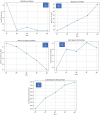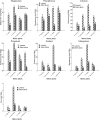Effect of harvest timing and plant parts on the nutritional and chemical profile of five potential fodder plants found in eastern coast of United Arab Emirates
- PMID: 38762677
- PMCID: PMC11102444
- DOI: 10.1038/s41598-024-62258-x
Effect of harvest timing and plant parts on the nutritional and chemical profile of five potential fodder plants found in eastern coast of United Arab Emirates
Abstract
Selecting highly nutritive fodder plants in arid regions can be a key to improving the livestock productivity. This work explores the variation in nutritive value of the leaves, stem, and shoots of five potential fodder plants of the Emirates of Fujairah, Erucaria hispanica, Haplophyllum tuberculatum, Convolvulus virgatus, Teucrium stocksianum, and Cleome Ibrachycarpa. influenced by two weather conditions, winter and spring. The plant samples underwent mineral composition, proximate, phytochemical, and heavy metals and two-way ANOVA. Weather data were accessed from National Center of Meteorology (NCM). Our findings reveal significant influences of collection time and species on nutritive content. Shoots collected in March exhibited higher ash (6.167%), crude protein (11.9%), crude fiber (14.89%), dry matter (45.86%), and total digestive nutrients (TDS) (48.35%), with lower tannin (5.11%) compared to January. Conversely, January-collected shoots had greater total sugar content (1.28 g/100 g). Plant organs played a crucial role, with leaves surpassing stems in Mg, P, Ca, K, Na, Mn, Zn, and Ni. Leaves also showed higher crude protein (23.33%), dry matter (92.26%), total ash (4.8%), and TDS (87.58%) compared to stems, while stems exhibited elevated crude fiber (17.45%) and tannin (4.53%). There is a need to assess the bioactive compounds found in these fodder species for the enhancement its effective use and maximize browsing of these species.
Keywords: Harvest time; Heavy metal analyses; Mineral; Native plants; Phytochemical; Plant-parts; Proximate; Shoots.
© 2024. The Author(s).
Conflict of interest statement
The authors declare no competing interests.
Figures






Similar articles
-
Leaves of Cleome amblyocarpa Barr. And Murb. And Cleome arabica L.: Assessment of nutritional composition and chemical profile (LC-ESI-MS/MS), anti-inflammatory and analgesic effects of their extracts.J Ethnopharmacol. 2021 Apr 6;269:113739. doi: 10.1016/j.jep.2020.113739. Epub 2021 Jan 12. J Ethnopharmacol. 2021. PMID: 33359854
-
Proximate Composition and Nutritional Values of Selected Wild Plants of the United Arab Emirates.Molecules. 2023 Feb 3;28(3):1504. doi: 10.3390/molecules28031504. Molecules. 2023. PMID: 36771169 Free PMC article.
-
Sweet potato (Ipomoea batatas L.) leaves as nutritional and functional foods.Food Chem. 2014 Aug 1;156:380-9. doi: 10.1016/j.foodchem.2014.01.079. Epub 2014 Feb 5. Food Chem. 2014. PMID: 24629984
-
[Yield and chemical composition of the vegetal parts of the amaranth (Amaranthus hypochondriacus, L.) at different physiological stages].Arch Latinoam Nutr. 1987 Mar;37(1):108-21. Arch Latinoam Nutr. 1987. PMID: 3454611 Spanish.
-
Safety and nutritional assessment of GM plants and derived food and feed: the role of animal feeding trials.Food Chem Toxicol. 2008 Mar;46 Suppl 1:S2-70. doi: 10.1016/j.fct.2008.02.008. Epub 2008 Feb 13. Food Chem Toxicol. 2008. PMID: 18328408 Review.
Cited by
-
Altitudinal influence on survival mechanisms, nutritional composition, and antimicrobial activity of Moringa Peregrina in the summer climate of Fujairah, UAE.Sci Rep. 2025 Feb 15;15(1):5635. doi: 10.1038/s41598-025-90223-9. Sci Rep. 2025. PMID: 39955360 Free PMC article.
References
-
- Otsuka, k. Population pressure, land Tenure, and natural resource management. ADB Institute Working Paper 1–27 https://www.adb.org/sites/default/files/publication/157197/adbi-rp16.pdf (2001).
-
- Golla B. Agricultural production system in arid and semi-arid regions. JAST. 2021;7:234–244.
-
- Zahedi S, Karimi M, Venditti A. Plants adapted to arid areas: specialized metabolites. Nat. Prod. Res. 2019;35:1–18. - PubMed
-
- Rathore M. Important lesser-known wild edible plants of arid and semi-arid zone of Rajasthan. For. Bull. 2012;12:56–60.
MeSH terms
LinkOut - more resources
Full Text Sources
Research Materials
Miscellaneous

